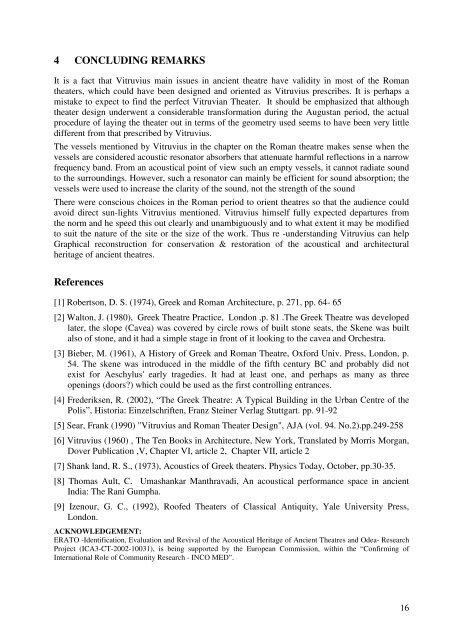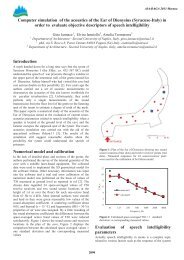ERATO Proceedings Istanbul 2006.pdf - Odeon
ERATO Proceedings Istanbul 2006.pdf - Odeon
ERATO Proceedings Istanbul 2006.pdf - Odeon
You also want an ePaper? Increase the reach of your titles
YUMPU automatically turns print PDFs into web optimized ePapers that Google loves.
4 CONCLUDING REMARKS<br />
It is a fact that Vitruvius main issues in ancient theatre have validity in most of the Roman<br />
theaters, which could have been designed and oriented as Vitruvius prescribes. It is perhaps a<br />
mistake to expect to find the perfect Vitruvian Theater. It should be emphasized that although<br />
theater design underwent a considerable transformation during the Augustan period, the actual<br />
procedure of laying the theater out in terms of the geometry used seems to have been very little<br />
different from that prescribed by Vitruvius.<br />
The vessels mentioned by Vitruvius in the chapter on the Roman theatre makes sense when the<br />
vessels are considered acoustic resonator absorbers that attenuate harmful reflections in a narrow<br />
frequency band. From an acoustical point of view such an empty vessels, it cannot radiate sound<br />
to the surroundings. However, such a resonator can mainly be efficient for sound absorption; the<br />
vessels were used to increase the clarity of the sound, not the strength of the sound<br />
There were conscious choices in the Roman period to orient theatres so that the audience could<br />
avoid direct sun-lights Vitruvius mentioned. Vitruvius himself fully expected departures from<br />
the norm and he speed this out clearly and unambiguously and to what extent it may be modified<br />
to suit the nature of the site or the size of the work. Thus re -understanding Vitruvius can help<br />
Graphical reconstruction for conservation & restoration of the acoustical and architectural<br />
heritage of ancient theatres.<br />
References<br />
[1] Robertson, D. S. (1974), Greek and Roman Architecture, p. 271, pp. 64- 65<br />
[2] Walton, J. (1980), Greek Theatre Practice, London ,p. 81 .The Greek Theatre was developed<br />
later, the slope (Cavea) was covered by circle rows of built stone seats, the Skene was built<br />
also of stone, and it had a simple stage in front of it looking to the cavea and Orchestra.<br />
[3] Bieber, M. (1961), A History of Greek and Roman Theatre, Oxford Univ. Press, London, p.<br />
54. The skene was introduced in the middle of the fifth century BC and probably did not<br />
exist for Aeschylus' early tragedies. It had at least one, and perhaps as many as three<br />
openings (doors?) which could be used as the first controlling entrances.<br />
[4] Frederiksen, R. (2002), “The Greek Theatre: A Typical Building in the Urban Centre of the<br />
Polis”, Historia: Einzelschriften, Franz Steiner Verlag Stuttgart. pp. 91-92<br />
[5] Sear, Frank (1990) "Vitruvius and Roman Theater Design", AJA (vol. 94. No.2).pp.249-258<br />
[6] Vitruvius (1960) , The Ten Books in Architecture, New York, Translated by Morris Morgan,<br />
Dover Publication ,V, Chapter VI, article 2, Chapter VII, article 2<br />
[7] Shank land, R. S., (1973), Acoustics of Greek theaters. Physics Today, October, pp.30-35.<br />
[8] Thomas Ault, C. Umashankar Manthravadi, An acoustical performance space in ancient<br />
India: The Rani Gumpha.<br />
[9] Izenour, G. C., (1992), Roofed Theaters of Classical Antiquity, Yale University Press,<br />
London.<br />
ACKNOWLEDGEMENT:<br />
<strong>ERATO</strong> -Identification, Evaluation and Revival of the Acoustical Heritage of Ancient Theatres and Odea- Research<br />
Project (ICA3-CT-2002-10031), is being supported by the European Commission, within the “Confirming of<br />
International Role of Community Research - INCO MED”.<br />
16
















